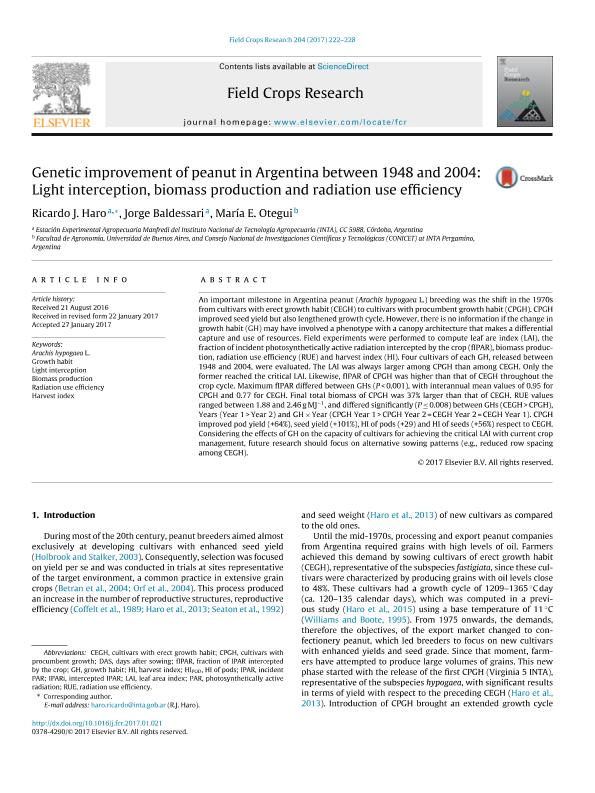Artículo
Genetic improvement of peanut in Argentina between 1948 and 2004: Light interception, biomass production and radiation use efficiency
Fecha de publicación:
03/2017
Editorial:
Elsevier Science
Revista:
Field Crops Research
ISSN:
0378-4290
Idioma:
Inglés
Tipo de recurso:
Artículo publicado
Clasificación temática:
Resumen
An important milestone in Argentina peanut (Arachis hypogaea L.) breeding was the shift in the 1970s from cultivars with erect growth habit (CEGH) to cultivars with procumbent growth habit (CPGH). CPGH improved seed yield but also lengthened growth cycle. However, there is no information if the change in growth habit (GH) may have involved a phenotype with a canopy architecture that makes a differential capture and use of resources. Field experiments were performed to compute leaf are index (LAI), the fraction of incident photosynthetically active radiation intercepted by the crop (fIPAR), biomass production, radiation use efficiency (RUE) and harvest index (HI). Four cultivars of each GH, released between 1948 and 2004, were evaluated. The LAI was always larger among CPGH than among CEGH. Only the former reached the critical LAI. Likewise, fIPAR of CPGH was higher than that of CEGH throughout the crop cycle. Maximum fIPAR differed between GHs (P < 0.001), with interannual mean values of 0.95 for CPGH and 0.77 for CEGH. Final total biomass of CPGH was 37% larger than that of CEGH. RUE values ranged between 1.88 and 2.46 g MJ−1, and differed significantly (P ≤ 0.008) between GHs (CEGH > CPGH), Years (Year 1 > Year 2) and GH × Year (CPGH Year 1 > CPGH Year 2 = CEGH Year 2 = CEGH Year 1). CPGH improved pod yield (+64%), seed yield (+101%), HI of pods (+29) and HI of seeds (+56%) respect to CEGH. Considering the effects of GH on the capacity of cultivars for achieving the critical LAI with current crop management, future research should focus on alternative sowing patterns (e.g., reduced row spacing among CEGH).
Archivos asociados
Licencia
Identificadores
Colecciones
Articulos(SEDE CENTRAL)
Articulos de SEDE CENTRAL
Articulos de SEDE CENTRAL
Citación
Haro Juarez, Ricardo Javier; Baldessari, Jorge; Otegui, Maria Elena; Genetic improvement of peanut in Argentina between 1948 and 2004: Light interception, biomass production and radiation use efficiency; Elsevier Science; Field Crops Research; 204; 3-2017; 222-228
Compartir
Altmétricas




